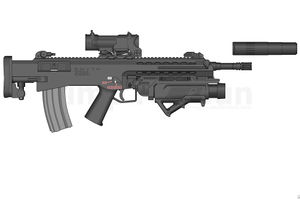Smyth SR44
| Smyth SR44 | |
|---|---|
 Smyth SR44 in G68 specification shown with Smyth Optics 3.4x28 sight, Smyth L44 Underbarrel Munitions Launcher, and Smyth SP44 suppressor | |
| Type | Assault Rifle |
| Place of origin | Grasmere |
| Service history | |
| In service | 2001-Present |
| Used by |
|
| Production history | |
| Designer | Brad Smyth |
| Designed | 1999 |
| Manufacturer | Smyth Industries |
| Produced | 2000-Present |
| Number built | 200,000 |
| Variants | SR44 DMR |
| Specifications | |
| Weight | 7.7 lb (3.5 kg) |
| Length | 27.8 in (710 mm) |
| Barrel length | 18 in (460 mm) |
| Width | 3.1 in (78.7 mm) |
| Height | 10.2 in (259.1 mm) |
|
| |
| Cartridge | 6.8 SPC |
| Action | Gas Operated, Rotating Bolt |
| Rate of fire | 800 rounds/min |
| Muzzle velocity | 850 m/s from a 7.5-gram (115 gr) Full Metal Jacket (FMJ) bullet |
| Effective firing range | 500 m |
| Feed system | 30-round STANAG type box magazine |
| Sights | Smyth Optics 3.4x28mm scope, Smyth Optics 3.5–10×40mm (SR44 DMR), East Systems 2.5-10x24mm Night Vision/Thermal (SR44 DMR)(Optional), Flip-up rail mounted iron sights |
The Smyth SR44 is a bullpup assault rifle, chambered in the 6.8 SPC and designed by Smyth of Grasmere. It was designed to replace the antiquated GDS G556 assault rifle as the standard service rifle of the Grasmeran Armed Forces. It competed, and won, against the East Systems MCAR in a 1999 Armed Forces competition.
Design
The SR44 features a long-stroke piston system and heavy duty dust covers and gaskets to improve reliability in harsh conditions. The weapon is designed to be operated ambidextrously; by closing one of the dust covers and using a bullet tip to turn the ejector, bullets can be routed away from the face of a left-handed user. The fire select switch, bolt handle and grenade launcher trigger are all present on both sides of the weapon as well. The weapon comes integrated with the Smyth L44 Under-Barrel Munitions Launcher, a 40mm breech-loaded grenade launcher. The trigger for the launcher is positioned so the operator won't have to remove their hand from the grip to operate the launcher. The majority of the weapon is constructed from polymer, and some sections of the stock are produced using 3D printing.
Users
 Grasmere: Grasmeran Army, Grasmeran Navy, Eureka Capital Guard, Military Police and various local police departments. In service with the Grasmeran Armed Forces as the G68 since 2001.
Grasmere: Grasmeran Army, Grasmeran Navy, Eureka Capital Guard, Military Police and various local police departments. In service with the Grasmeran Armed Forces as the G68 since 2001.
